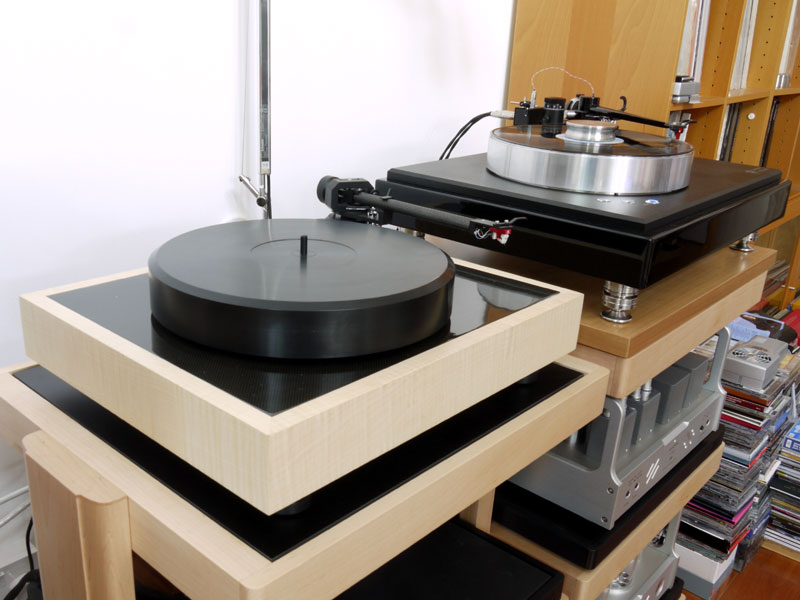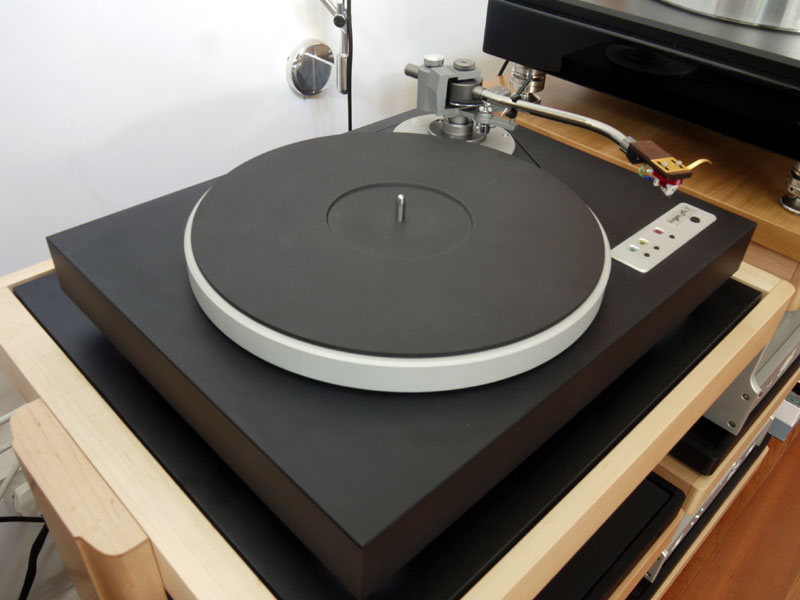Blasts From the Past? The New Generation of Direct-Drive Turntables
elt-drive turntables have ruled the high-end roost for nearly four decades, but nowhere has their dominance been more secure than in the UK -- by no coincidence, home of the Linn LP12, the ‘table that, if it didn’t exactly start the belt-drive/suspended-subchassis "revolution," was the one that fought (and won) its major battles. If hi-fi is a world characterized by unthinking (and often uncritical) devotion to particular technologies, nothing quite matches the quasi-religious fervor with which Linn’s acolytes swept away the opposition, consigning (mainly Japanese) direct-drive turntables as well as linear-tracking tonearms and half a dozen other potentially fertile analog developments to the dustbin of history, topping them off with a thick layer of the "upstart" competition. There was only one true turntable and that turntable was the LP12. Like a tsunami spreading from a volcanic eruption, the Linn jihad might have waned in strength the further it spread from Glasgow, but there was barely a hi-fi market that remained immune. Meanwhile, within the home islands, we were all either baptized and born again or up to our necks in it. The power and all-pervasive nature of that dogma is hard to imagine unless you experienced it. The LP12 was so dominant that it even defined the opposition, each new competitor having to try and hit the price points defined by the Linn and to work with the systems and ancillaries designed for it. Perhaps it’s no surprise that none succeeded in displacing the incumbent, leaving the LP12 to hold sway over the UK’s declining analog market, a status it still enjoys. I was working in hi-fi retail back in the early ‘80s, when the Scottish Inquisition was at the height of its powers, but I was never one to follow the crowd. Even then I remember being impressed by the direct-drive Goldmund Studio and -- the ultimate heresy -- even selling a couple, albeit without the uber-flaky T3F tonearm. Hey, it was a suspended deck! That’s my story and I’m sticking to it. But such products and sales became increasingly rare. I might have jumped ship, first to the Eminent Technology ET2 and shortly after to the first of many VPI ‘tables, but at least in this regard I was the exception and definitely not the rule. The popularity of the Roksan Xerxes and various Pink Triangles might have been faint glimmers in the pervasive gloom, but they did little to challenge the belt-drive/suspended-subchassis hegemony and were soon snuffed out by Linn’s dominance of the shrinking market and the rise of CD. So, given that history, you can imagine the mixture of bemused surprise and amused satisfaction that greets the sight, some thirty years later, of not one but three direct-drive turntables sitting in my listening room. If anything ever demonstrated the truth that, at least in hi-fi terms, what goes around comes around does it quietly and at a constant speed, then this is it. The recently reviewed VPI Classic Direct isn’t exactly news. It was heavily trailed even before its appearance, while its performance (and novel 3D printed tonearm) has attracted even more attention, substantially redrawing the map of the analog market along the way. The only (well okay, the main) issue is the price -- $30,000 isn’t exactly pocket change, which places the Classic Direct’s charms beyond the reach of most analog devotees. Which is where the other two ‘tables I’m looking at come in.
The VPI (above right) is far from the only and a long way from being the first serious direct-drive deck out there (I’m not even going to mention the various Technics decks and their cult following). The Rockport Sirius III used a combined direct-drive, biaxial air-bearing motor, while at more approachable price points the Brinkmann Oasis and Bardo both used the company’s own direct-drive motor/bearing assembly, but even those look like Johnny-come-latelys when compared to the first of our alternatives here. The Motus turntable from STST (above left) first appeared in the late ‘80s and, like the Brinkmann, relies on an in-house direct-drive motor/bearing solution. Even more unusually, in the shape of the Motus II, it also offers a sophisticated, highly tunable, counterbalanced suspended subchassis, perhaps explaining the resolutely traditional appearance of the deck. Despite the depth of the massive Delrin platter, this turntable, with its square plinth and round armboard, wouldn’t look out of place in a Thorens catalog, which is no bad thing when it comes to domestic harmony. Combine that with what’s inside and that’s a lot of nicely packaged engineering for the comparatively modest price of £5000 in the UK, including 20% sales tax! STST also offers its own tonearm, the £2800 Vertex, which bears a striking resemblance to the late, great Mission Mechanic, albeit with a large-bore carbon-fiber tube in place of the machined and variable-wall-thickness aluminum tube of its inspiration. However, just as the ‘table treads its own distinct path, this is no slavish copy, the familiar appearance owing more to the converging trends that characterized accepted practice at the time of its development. Execution is exemplary, and there are more than a few neat touches in the design, including a choice of 9", 10" or 12" effective lengths. The one in the picture is the 10" version that was supplied with the deck for review, although I’ll also be listening to the STST with other 'arms to try and further isolate its specific attributes. Our second offering also hails (like the Brinkmanns and the STST) from Germany, possibly reflecting the fact that the existence of and familiarity with the Thorens TD 150/160 series and their various offshoots provided a degree of insulation from the Linn’s almost magical status. That and a national obsession with technically robust engineering solutions helps explain why direct-drive ‘tables managed to not only survive but ultimately to flourish. Okay, so there are still plenty of German belt-drives out there, but four indigenous direct-drive designs are still four more than the combined nations of the UK can muster.
The Langer No.7 (above) is, if anything, even more retro in appearance than the STST, its slim-line plinth, small footprint and shallow platter reminiscent of the later Japanese direct-drives so despised by the flat-earth evangelists. With the satin-finished S-shaped Jelco tonearm mounted it looks like it has stepped straight out of the ‘70s. But weighing in at around 55 pounds, all you need to do is pick it up to appreciate the difference. Where so many of those cheap Japanese decks used molded-plastic plinths and lightweight cast platters, the Langer No.7 has a solid machined aluminum plinth and a 6.5-pound machined alloy platter, carefully calculated to deliver optimum performance with the direct-drive motor. The deck incorporates a simple subchassis suspended on polymer isolators and again relies on its own in-house bearing/drive system and control electronics, which, unlike those for the STST that employ a small external power supply, are housed entirely internally. But what makes the Langer deck even more interesting is that what you see here is just the top model, costing around €7890. The deck is also available in a range of wood-veneered MDF plinths (€7490), and as a motor unit alone (€3490 including a motor housing and all associated electronics). That’s right -- all you "I could build a way better deck than that in my garden shed!" DIYers need wait no longer. Here’s a bang-up-to-date platter/drive system and all the associated electronics just crying out for you to let your creative juices flow. In the meantime, I’ll be listening to the Langer
No.7 with its aluminum plinth alongside the STST, with both the same and alternative
tonearms. I can hardly wait. |


